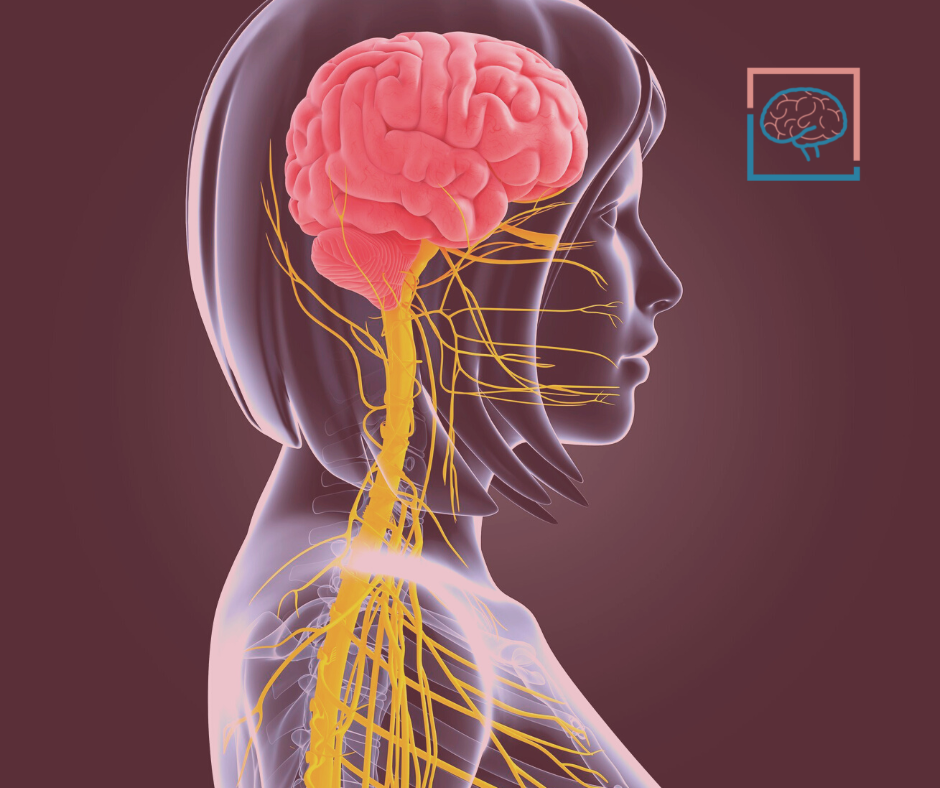If you’re constantly stressed, or on edge, you might want to give your nervous system a break. Your nervous system is responsible for maintaining homeostasis, so dysregulation can lead to a host of health problems, both physical and mental.
Rebalancing your nervous system can reduce stress, improve mental clarity, and build resilience to daily obstacles.
The Nervous System: Wiring your Circuit Board
Your nervous system is a complex system comprised of hardware (brain) and circuitry (nerves) that interacts with every organ and system in your body.
Your body receives information from the environment (sensations, information, stressors, etc.) and processes this information. The result is a behavioral or physiological response.
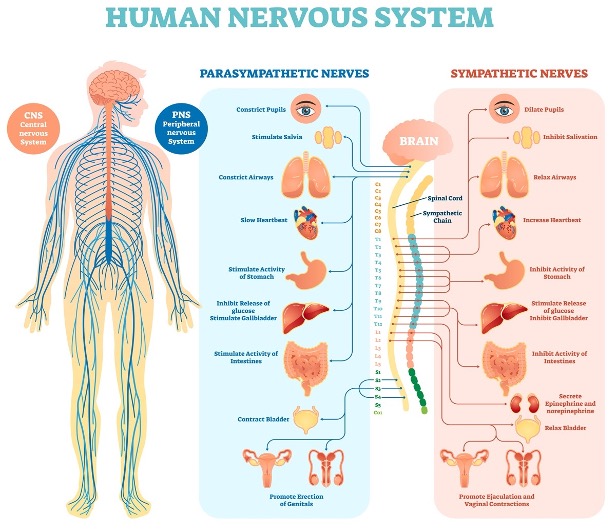
Fight/Flight/Freeze vs. Rest & Digest
The autonomic nervous system has two branches:
- Sympathetic Nervous System (SNS): “Fight/flight/freeze.” This division is associated with trying to escape a threat or avoid danger. Although useful in the short term, being in flight, fight, or freeze mode long-term can result in chronic stress on the body and prolonged feelings of anxiety or depression.
- Parasympathetic Nervous System (PNS): “Rest & digest.” When this system is in charge, our body can relax. Our cellular energy is focused on healing, digestion, and relaxation. The Vagus nerve (the only nerve that connects our stomach to our brain) activates the rest and digestive system.
Fun fact: You can stimulate the vagus nerve by singing, brushing your teeth, or massaging the sides of your neck.
When faced with threatening stimuli, the SNS launches a fight/flight/freeze response, resulting in stress and anxiety. During calm periods, the PNS manages rest & digest processes, allowing your body to heal and repair.
Not being able to feel calm throughout the day is usually a sign of a dominant sympathetic nervous system. The goal of resetting your nervous system is to move from SNS dominance towards PNS balance.
“Neurons that fire together, wire together.”
Our thoughts, feelings, and emotions are regulated by our nervous system. The saying “neurons that fire together, wire together” holds true as our thoughts become hardwired into our nervous system, ultimately guiding our behavior.
In layman’s terms, your daily thoughts, emotions, and behaviors become ingrained in your neural circuitry over time. This is part of the Hebbian Learning Rule.
Think of it like this: If you hear a song at a funeral, odds are hearing that song might make you sad for years, because it has been “wired to” a sad event. Conversely, you might think of that song when you feel sad about something else.
Our brains work the same way; a thought or stimulus can trigger an emotional or physiological response that leads to altered behavior.
Constant negative thoughts or self-criticism can become wired into your nervous system if you aren’t careful. This can become a vicious cycle if you wire negative thoughts to commonplace events.
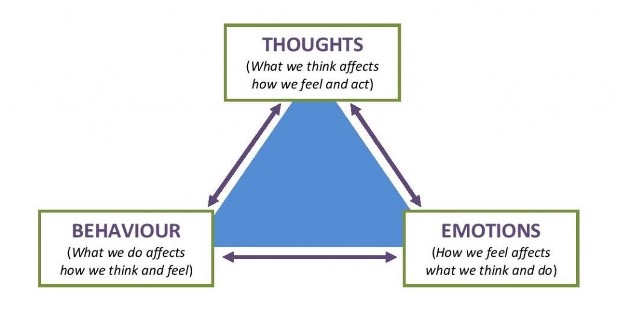
Changing your mindset. It is not the stressor that determines the response; instead, it is the individual’s internal reaction that triggers a response. In other words, it’s how we interpret stress that counts!
The good news is we have the willpower to change our thoughts from negative to positive, reduce our body’s burden to stress, and support our nervous system to become resilient!
“The mind can go either direction under stress—toward positive or toward negative: on or off. Think of it as a spectrum whose extremes are unconsciousness at the negative end and hyperconsciousness at the positive end. The way the mind will lean under stress is strongly influenced by training.”
— Frank Herbert
Need a tool for building positive thought patterns? Repeat this mantra every morning and before bed:
“I give myself permission to be human and I accept my deficits and flaws. I am making daily improvements, and I am worthy and deserving”
What is stress?
The American Psychological Association defines stress as “the physiological or psychological response to internal or external stressors.” When we discuss “stressors,” we could be referring to a broad range of stimuli, including but not limited to:
- Heat or cold
- Chemical toxins
- Microorganisms
- Physical trauma
- Hormonal imbalance
- Strong emotional reactions
When it comes to dealing with stress, it is important to understand that your body innately strives for relaxation. Your nervous system is responsible for maintaining homeostasis. Anything that disrupts homeostasis adds extra work, or strain.
When external stressors create obstacles, your nervous system diverts work from other areas, like immune system function. In fact, long-term stress has been associated with a multitude of chronic diseases and symptoms, including:
- Chronic fatigue syndrome (CFS)
- Type 2 diabetes
- High blood pressure
- Cardiovascular disease
- Immune dysregulation
- Alzheimer’s disease and dementia
- Depression and cognitive decline
- Digestive issues
- Sleep disorders
Cortisol: The Stress Hormone
Cortisol is the stress hormone that is secreted by your adrenal glands in response to psychological or environmental stress. This hormone is necessary for vital bodily functions. Cortisol is at its highest in the morning, but declines throughout the day and alerts melatonin to increase before bed.
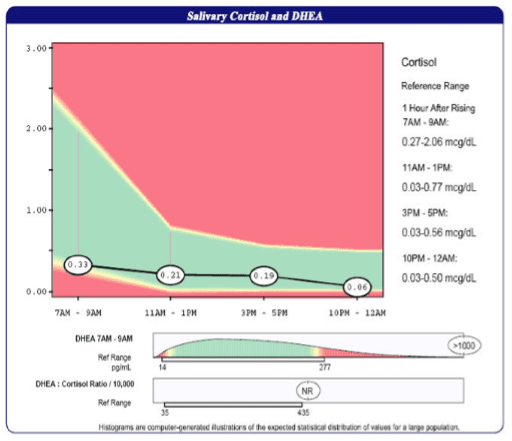
In chronically stressed individuals, cortisol may remain elevated throughout the day, resulting in feelings of sustained fatigue and an inability to go to sleep at night. These individuals usually experience digestive issues, chest palpitations, and anxiety.
Cortisol may eventually be secreted at lower than optimal levels resulting in “adrenal fatigue”.
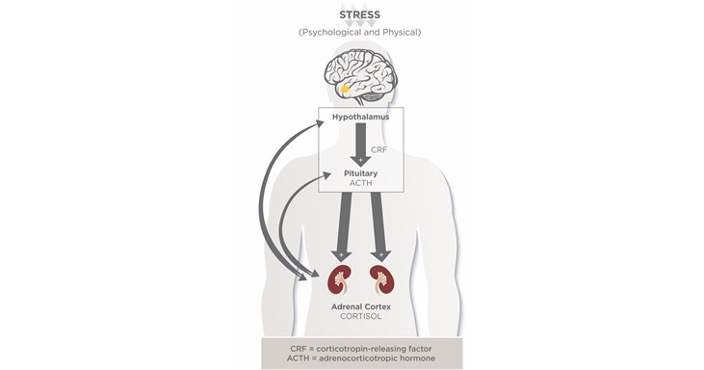
General Adaptation Syndrome (GAS) is the process your body goes through when exposed to a stressful environment or situation. The adrenal glands guide GAS through 3 phases: alarm, resistance, and exhaustion.
Alarm
This is traditionally known as the “fight or flight response.” More recently, experts have updated the language of the alarm phase to the “fight, flight or freeze response.”
This phase is activated by the SNS and the hypothalamic-pituitary- adrenal (HPA) axis, which causes adrenals to secrete adrenaline and cortisol. During this phase:
- Heart rate increases to provide blood flow to areas necessary for response to the stressful situation.
- Blood is shunted away from the skin and internal organs and diverted to the muscles and brain.
- Breathing rate increases.
- Sweat increases to remove toxic compounds and to lower body temperature.
- Digestive secretion of enzymes is produced.
- Blood sugar spikes.
Resistance
During this phase, your body tries to reorient itself after the initial stress response. This could mean making changes required to meet emotional crises, perform strenuous tasks, or fight infection.
If the stressor is gone, your body should calm down during this stage. However, prolonged stress causes your SNS and HPA to continue secreting stress hormones. This can prolong the physical effects of stress, and make it difficult to move on the the next stage when the stressor does go away.
The effects of adrenal cortex hormones are necessary when the body is faced with danger. But a prolonged resistance reaction (or continued stress) increases the risk of significant disease.
Exhaustion
Prolonged stress leads to this final stage of GAS. Exhaustion is characterized by depleted cortisone and loss of PNS function. Symptoms of exhaustion include:
- Fatigue
- Irritability
- Muscle aches
- Weakness
- Slowed reflexes/responses
How to Rebalance Your Nervous System
Now that you’ve learned the mechanisms behind what causes stress, it’s time to optimize your stress resilience.
Following a 4-week protocol, you’ll be able to:
- Optimize cortisol levels by regulating the HPA axis
- Support healthy energy through of diet of targeted nutrients and some lifestyle changes
- Activate the parasympathetic nervous system (Rest & Digest) by the vagus nerve and mindfulness
- Support brain health to improve memory and cognition.
- Condition your body to increase stamina to environmental stressors.
How do you rebalance the nervous system? You can rebalance your nervous system by changing your diet, taking supplements, and adding a few simple self-care techniques to your daily routine.
Diet
Our eating habits impact our physical and mental health. To boost your overall well-being, try this protocol for 4 weeks:
| When you wake up | Pinch of sea salt or electrolyte solution in filtered water |
| Breakfast | Protein & healthy fats (like avocados), vegetables |
| Vegetables | 2 cups throughout the day (non-starchy) |
| Caffeine | None before breakfast or after 1 pm (avoid dairy creamers and sugar) |
| Water | 2 liters, or ½ gallon per day |
| Omit | Refined carbohydrates and simple sugars (e.g. breads, pasta, desserts, flour pizza crust, or French fries) |
Supplements
To regulate your nervous system quickly, you’ll also want to stock up on some supplements to boost your nutrient intake.
- Magnesium Threonate: 3 capsules daily. Supports cognition, memory, and vascular function.
- HPA adapt: 4 capsules daily.
- Ashwagandha: reduces cortisol levels throughout the day, acts as an antioxidant, boosts testosterone, and supports mood.
- Rhodiola Rosea: helps regulate stress, improve mood, and eliminate “burn out”.
- Siberian ginseng: Increases stamina, improves mood, supports exercise results.
- Maca: Hormone support, increases stamina and mood throughout the day.
- L- theanine: 1 capsule daily. Activates alpha brain waves for an alert yet wakeful state. Active compound in green tea. Supports cognition and reduces anxiety.
Self-Care Routine
Conditioning your stress resilience will allow you to look at the world in a new light while overcoming obstacles that you never thought you could. Habit-forming skills will be essential during the first week as they will set the foundation and intention for the next 3 weeks.
These mindfulness techniques are simple ways to train your body and mind to handle stressors differently. Try to do these daily:
- 10 minutes of sitting into emotions. This could mean meditation, journaling, or sitting in silence with your feelings.
- 10 minutes of deep breathing exercises. Similar to meditation, breath work focuses on your body rather than your emotions.
- 30 minutes of exercise.
- Spend some time outdoors.
- Buy a house plant. Indoor plants have been shown to reduce cortisol, improve mood, and oxygenate the room.
- Introduce cold showers. Improving your tolerance to a physical stressor can help retrain your SNS. Learn more about it here. Start with 30 seconds cold, 30 seconds warm, repeat 3 times, and increase cold as you learn to tolerate it.
- Get comfortable with the uncomfortable. Take notes on how you feel during this process.
It might help to tell a friend or loved one about your goals to help you stay on track. If you have any fitness devices, check to see if they monitor heart rate variability, so you can get an alert when you need to step back from a stressful situation.
Ready to Get Balanced?
Rebalancing your nervous system will take time and conscious effort. Know that you have all the tools you need, but you can ask for help. If you need more guidance, schedule a phone consultation with PrimeHealth, and we can help you get started.
Sources
- Keysers, C., & Gazzola, V. (2014). Hebbian learning and predictive mirror neurons for actions, sensations and emotions. Philosophical transactions of the Royal Society of London. Series B, Biological sciences, 369(1644), 20130175.
- SELYE H. (1950). Stress and the general adaptation syndrome. British medical journal, 1(4667), 1383–1392.
- Kozlowska, K., Walker, P., McLean, L., & Carrive, P. (2015). Fear and the Defense Cascade: Clinical Implications and Management. Harvard review of psychiatry, 23(4), 263–287.
- Tanaka, M., Tajima, S., Mizuno, K., Ishii, A., Konishi, Y., Miike, T., & Watanabe, Y. (2015). Frontier studies on fatigue, autonomic nerve dysfunction, and sleep-rhythm disorder. The journal of physiological sciences : JPS, 65(6), 483–498.
Lee, M. S., Lee, J., Park, B. J., & Miyazaki, Y. (2015). Interaction with indoor plants may reduce psychological and physiological stress by suppressing autonomic nervous system activity in young adults: a randomized crossover study. Journal of physiological anthropology, 34(1), 21.





